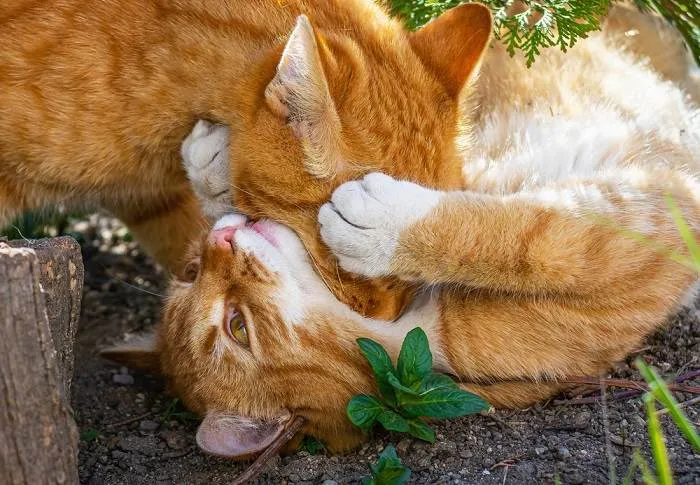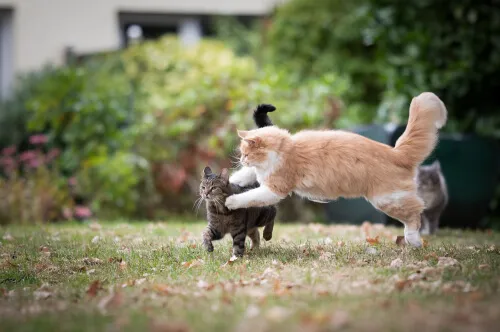Have you ever watched your cats and wondered, why do cats bite each other’s necks? This behavior might look alarming at first, resembling something straight out of the wild. Yet, as descendants of African wildcats, domestic cats retain many instinctual traits that play out in our homes. Neck biting is a normal part of feline communication, serving various purposes from play to mating. While it’s usually harmless, understanding the context helps cat owners distinguish between friendly interactions and potential issues. In this guide, we’ll explore the top five reasons behind this behavior, drawing from veterinary insights and feline behavior experts to help you better interpret your pets’ actions.
Key Takeaways
- Neck biting among cats is a natural, often harmless behavior rooted in their instincts.
- It commonly occurs during mating, play, dominance displays, hunting simulations, or due to underlying health problems.
- Monitor for signs of aggression like injury or distress, and consult a vet if behavior changes suddenly.
 Cats playfully biting each other's necks during a play session
Cats playfully biting each other's necks during a play session
1. Mating Behavior
One of the most common reasons cats bite each other’s necks is during mating. When a male cat, or tom, mounts a female in heat, he grips the scruff of her neck with his teeth to keep her steady. This hold immobilizes her gently, preventing her from moving or turning to scratch him while he’s vulnerable. The bite triggers a natural calming response, similar to how mother cats carry kittens by the scruff without causing harm.
Mother cats also use this technique to transport their litters safely to a new nesting spot or away from danger. The loose skin at the neck protects kittens’ delicate bodies, and the scruff grip instinctively relaxes their muscles, making handling easier. According to the American Association of Feline Practitioners (AAFP), this reflex persists from kittenhood into adulthood, explaining its role in reproduction.
If you have unspayed cats, this behavior spikes during heat cycles. Spaying or neutering can reduce it significantly, promoting calmer household dynamics. For more on heat signs, resources from veterinary sites like the ASPCA highlight symptoms such as increased vocalization and rubbing.
2. Play and Social Learning
Kittens and young cats frequently bite necks during play-fighting, which is essential for development. This roughhousing mimics real hunting and combat, allowing them to practice pouncing, wrestling, and boundary-setting with siblings or littermates. The neck bite provides instant feedback—if too hard, the playmate reacts, teaching bite inhibition.
Adult cats continue this in moderated play, often with toys or each other, to relieve energy and strengthen bonds. If your cat suddenly bites during petting sessions, it might signal overstimulation, a common “love bite” indicating they’ve had enough interaction. Feline behaviorists note that play biting hones social skills, preventing overly aggressive adults later.
Encourage healthy play with interactive toys like wand teasers to channel this instinct safely. In multi-cat homes, supervised play sessions build harmony, as supported by studies from the Journal of Feline Medicine and Surgery on social play’s role in reducing stress.
3. Dominance and Territorial Disputes
In households with multiple cats, neck biting often signals dominance or resource guarding. Cats establish hierarchies through subtle cues, escalating to neck grips when asserting control over food, litter boxes, toys, or prime sleeping spots. Outdoor cats may do this with neighbors over territory, especially intact males marking with urine.
A dominant cat pins the subordinate by the neck, a non-lethal display echoing wildcat confrontations. This maintains order without serious injury in most cases. However, integrating a new cat requires patience—sudden introductions can provoke prolonged conflicts.
Veterinarians recommend vertical spaces like cat trees and multiple resources per cat (e.g., one litter box per cat plus one extra) to minimize disputes. The International Cat Care organization emphasizes slow introductions over days or weeks for success.
 Two cats engaged in a dominance fight, one biting the other's neck
Two cats engaged in a dominance fight, one biting the other's neck
Signs of true fighting include flattened ears, arched backs, growling, and swatting—unlike playful rolling and relaxed tails. Intervene safely with distractions like noise or barriers, never hands.
4. Hunting Instincts
Cats’ predatory drive compels neck biting as a way to subdue “prey.” In the wild, biting the neck severs the spine or restricts blood flow, quickly immobilizing targets. Domestic cats channel this through play with toys, littermates, or even ankles, practicing stalk-pounce-bite sequences.
This burst of energy satisfies their need to hunt, even without real prey. Toys mimicking small animals trigger it best, keeping cats mentally stimulated and physically fit. Obesity and boredom amplify unwanted targeting of housemates.
Provide daily enrichment like puzzle feeders or laser pointers, as recommended by the Cornell Feline Health Center, to fulfill these instincts indoors.
5. Aggression from Medical or Stress Issues
While usually benign, excessive or sudden neck biting can indicate problems. Pain from conditions like arthritis, hyperthyroidism, or dental disease makes cats irritable, lashing out at companions. Neurological issues or hormonal imbalances alter behavior too.
Stressors—new pets, moves, or routine changes—heighten aggression. Watch for symptoms like hiding, appetite loss, or vocalizing. A vet exam rules out health causes; bloodwork often reveals thyroid or kidney problems common in seniors.
 A cat aggressively biting another's neck, possibly due to stress or illness
A cat aggressively biting another's neck, possibly due to stress or illness
Behavioralists from the Animal Behavior Society advise pheromone diffusers or anxiety wraps for mild cases, but professional intervention is key if injuries occur.
When to Worry and How to Manage
Neck biting enriches cat life, but intervene if it causes wounds, fur loss, or fear. Separate aggressors temporarily, enrich environments, and consult vets for persistent issues. Neutering curbs hormone-driven bites, fostering peace.
By understanding why cats bite each other’s necks, you empower better care. Observe body language: relaxed play versus tense fights. Create a low-stress home with ample resources, and your cats will thrive.
Ready to enhance your cat’s well-being? Schedule a vet checkup and explore our guides on feline behavior for more tips.
Frequently Asked Questions
Is neck biting between cats normal?
Yes, gentle neck biting is a standard feline behavior for communication, play, and mating. It’s concerning only if aggressive or paired with injuries.
How to differentiate play from fighting?
Play involves loose bodies, no vocal aggression, and taking turns. Fights show stiff postures, hissing, growling, and intent to harm. Avoid direct intervention to prevent bites.
How to prevent excessive neck biting?
Provide resources, play outlets, and space. Spay/neuter, manage introductions, and address health/stress promptly for harmony.
References:
- American Association of Feline Practitioners (AAFP) guidelines on reproduction.
- Journal of Feline Medicine and Surgery on play behavior.
- International Cat Care resources on multi-cat households.
- ASPCA and Cornell Feline Health Center on instincts and health.
